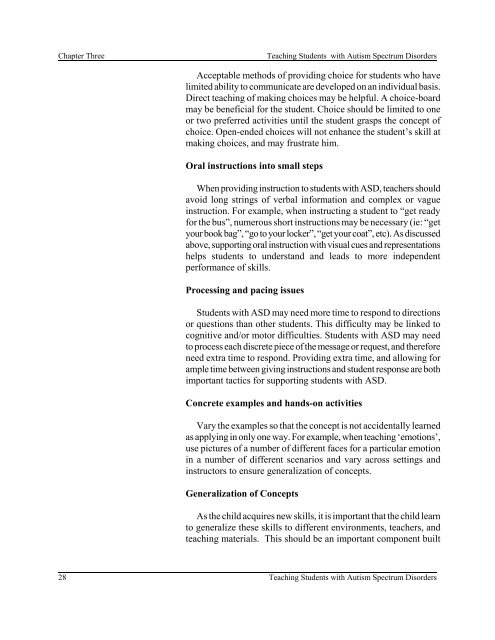Teaching Students with Autism Spectrum Disorders
Teaching Students with Autism Spectrum Disorders
Teaching Students with Autism Spectrum Disorders
Create successful ePaper yourself
Turn your PDF publications into a flip-book with our unique Google optimized e-Paper software.
Chapter Three <strong>Teaching</strong> <strong>Students</strong> <strong>with</strong> <strong>Autism</strong> <strong>Spectrum</strong> <strong>Disorders</strong><br />
Acceptable methods of providing choice for students who have<br />
limited ability to communicate are developed on an individual basis.<br />
Direct teaching of making choices may be helpful. A choice-board<br />
may be beneficial for the student. Choice should be limited to one<br />
or two preferred activities until the student grasps the concept of<br />
choice. Open-ended choices will not enhance the student’s skill at<br />
making choices, and may frustrate him.<br />
Oral instructions into small steps<br />
When providing instruction to students <strong>with</strong> ASD, teachers should<br />
avoid long strings of verbal information and complex or vague<br />
instruction. For example, when instructing a student to “get ready<br />
for the bus”, numerous short instructions may be necessary (ie: “get<br />
your book bag”, “go to your locker”, “get your coat”, etc). As discussed<br />
above, supporting oral instruction <strong>with</strong> visual cues and representations<br />
helps students to understand and leads to more independent<br />
performance of skills.<br />
Processing and pacing issues<br />
<strong>Students</strong> <strong>with</strong> ASD may need more time to respond to directions<br />
or questions than other students. This difficulty may be linked to<br />
cognitive and/or motor difficulties. <strong>Students</strong> <strong>with</strong> ASD may need<br />
to process each discrete piece of the message or request, and therefore<br />
need extra time to respond. Providing extra time, and allowing for<br />
ample time between giving instructions and student response are both<br />
important tactics for supporting students <strong>with</strong> ASD.<br />
Concrete examples and hands-on activities<br />
Vary the examples so that the concept is not accidentally learned<br />
as applying in only one way. For example, when teaching ‘emotions’,<br />
use pictures of a number of different faces for a particular emotion<br />
in a number of different scenarios and vary across settings and<br />
instructors to ensure generalization of concepts.<br />
Generalization of Concepts<br />
As the child acquires new skills, it is important that the child learn<br />
to generalize these skills to different environments, teachers, and<br />
teaching materials. This should be an important component built<br />
28 <strong>Teaching</strong> <strong>Students</strong> <strong>with</strong> <strong>Autism</strong> <strong>Spectrum</strong> <strong>Disorders</strong>

















